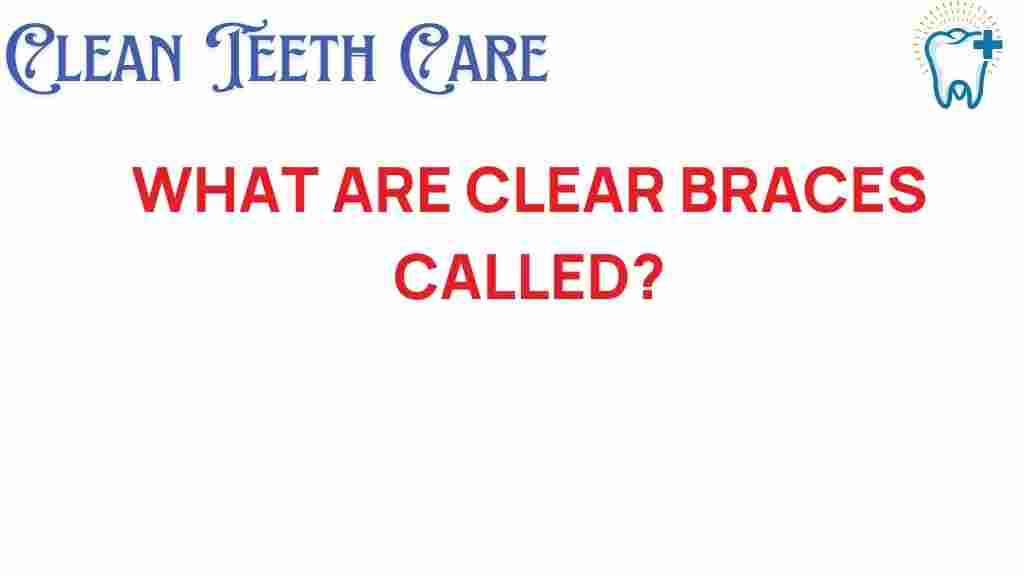Unveiling the Mystery: What Are Clear Braces Really Called?
When it comes to achieving a perfect smile, many people are curious about the options available to them in the realm of orthodontics. One popular choice is what many refer to as clear braces. However, the term “clear braces” can sometimes be misleading. In this article, we will explore what clear braces are really called, dive into the world of invisible aligners, and discuss their role in modern cosmetic dentistry and dental aesthetics. Whether you are an adult considering braces for the first time or someone seeking a smile makeover, this guide will provide you with the information you need.
Understanding Clear Braces
Before we delve deeper, let’s clarify what is commonly referred to as clear braces. The term typically includes a few different types of orthodontic devices designed to straighten teeth while minimizing visibility. These devices can be categorized into:
- Ceramic Braces: These are similar to traditional metal braces but use clear or tooth-colored brackets.
- Invisible Aligners: Most commonly known by brand names like Invisalign, these are custom-made plastic trays that gradually move your teeth into desired positions.
- Lingual Braces: These are attached to the back of the teeth, making them invisible from the front.
Each of these methods has its own advantages and is suitable for different types of orthodontic needs. Understanding these differences can help you make an informed decision for your teeth straightening journey.
How Clear Braces Work
Now that we’ve defined what clear braces really are, let’s discuss how they function in the world of orthodontics. The process generally involves several key steps:
1. Consultation with an Orthodontist
The first step in your journey to a straighter smile is a consultation with a qualified orthodontist. During this visit, the orthodontist will:
- Assess your dental health
- Discuss your cosmetic goals
- Determine if you are a candidate for clear braces or invisible aligners
2. Customized Treatment Plan
Once you decide on a treatment method, your orthodontist will create a customized plan tailored to your specific needs. This may involve:
- Taking digital impressions or molds of your teeth
- Creating a 3D model for invisible aligners
- Outlining the timeline for your smile makeover
3. Fitting and Adjustments
If you choose invisible aligners, you will receive a series of trays to wear, each designed to shift your teeth incrementally. For ceramic or lingual braces, the orthodontist will attach the brackets and wires to your teeth. Regular adjustments will be necessary to ensure progress, typically every 4-8 weeks.
4. Retaining Your Results
After your teeth have been straightened, it’s important to maintain your new smile. This often involves wearing a retainer, which will keep your teeth in their new positions. Your orthodontist will guide you on how long and when to wear it.
Benefits of Clear Braces
Choosing clear braces or invisible aligners comes with numerous benefits:
- Discreet Appearance: Clear braces are less noticeable than traditional metal braces, making them particularly appealing to adults and teens.
- Comfort: Many find that ceramic braces and invisible aligners are more comfortable than metal braces.
- Flexibility: With invisible aligners, you can remove them for eating, brushing, and flossing, making it easier to maintain oral hygiene.
- Effective Teeth Straightening: Both clear braces and invisible aligners are effective for a wide range of orthodontic issues.
These benefits contribute to the growing popularity of clear braces in the field of cosmetic dentistry.
Common Concerns and Troubleshooting Tips
While clear braces and invisible aligners offer many advantages, patients often have concerns. Here are some common issues and how to address them:
1. Discomfort
It’s common to experience some discomfort after getting braces or starting a new set of aligners. This usually subsides within a few days. Here are some tips:
- Use over-the-counter pain relief if necessary.
- Stick to soft foods for the first few days.
- Consider orthodontic wax for any areas where braces are rubbing against your mouth.
2. Difficulty Speaking
Invisible aligners may initially affect your speech. Practice speaking out loud to adjust more quickly. Most people find they adapt within a few days.
3. Maintaining Oral Hygiene
Keeping your teeth clean is vital, especially with braces. Follow these tips:
- Brush after every meal.
- Use interdental brushes to clean around brackets and wires.
- Floss daily using a floss threader or orthodontic floss.
4. Staining of Ceramic Braces
Ceramic braces can stain if you consume certain foods or beverages. Avoid:
- Coffee and tea
- Red wine
- Colored sodas and juices
If you do consume these, be sure to brush your teeth afterward.
Conclusion: The Path to Your Perfect Smile
In conclusion, the term clear braces encompasses a variety of orthodontic solutions such as ceramic braces and invisible aligners. Each option offers unique benefits and is designed to help you achieve your ideal smile while maintaining dental aesthetics. Whether you are an adult considering adult braces or a teen looking to enhance your smile, understanding your options can help you make the right choice.
As you embark on your smile makeover journey, remember that consulting with a qualified orthodontist is crucial. They will guide you through the process and help you achieve the beautiful, straight teeth you desire.
For more information on the different types of braces and to find an orthodontist near you, check out this helpful resource. And remember, a confident smile is just a few steps away!
This article is in the category Treatments and created by CleanTeethCare Team
